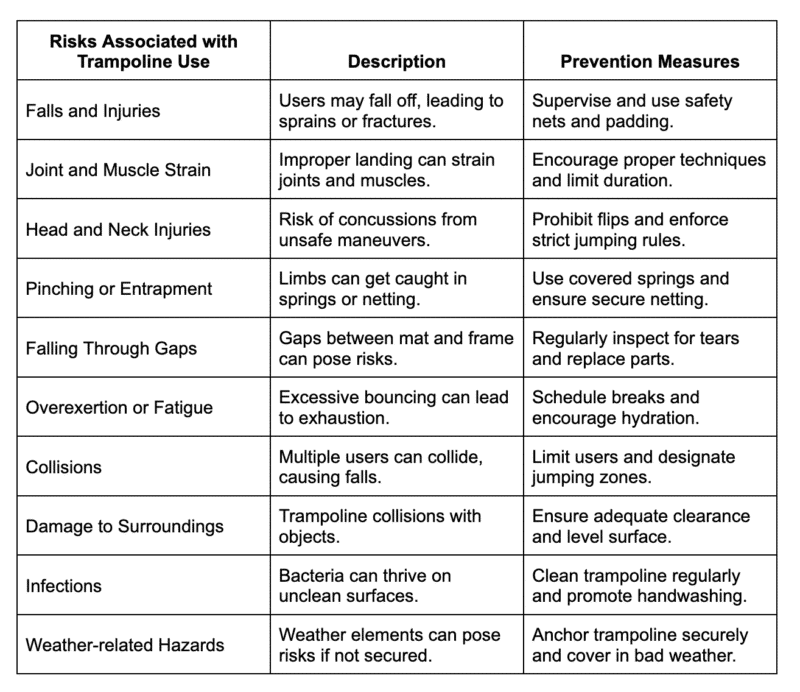Over the last several decades, home trampolines have evolved from mere leisure equipment to valuable assets for promoting health and well-being. For many, bouncing on a trampoline is a recreational activity and a means of enhancing longevity. This article will discuss how trampolines in your home can offer physical and emotional health benefits, such as better cardiovascular workouts and stronger muscle tones, reducing stress, and improving mood.
Physical Health Benefits
Cardiovascular Fitness
A key advantage of utilizing a home-based trampoline is an end in cardiovascular fitness. When a person jumps on the trampoline, their heart rate increases, blood flow improves, and cardiovascular strength is built. Cardiovascular running is a form of aerobic exercise that can make your heart and lungs stronger, reduce the risk of heart disease, and improve overall fitness.
Muscle Hardness and Tone
While using a trampoline at home, one does many different types of exercises, such as legs, core and arms. Repeating bouncing motions contributes to muscle tightening, resulting in a leaner physique and improved body composition. Consistent with this, the multifaceted deep muscles involved in landing and stabilizing on the trampoline surface involve high-level activation, which can result in strength improvement.
Bone Density
When you bounce up and down in the air, you exert weight-bearing exercise, which can strengthen your bones and aid in preventing osteoporosis. Each foot’s contact with the ground during bouncing provides resistance and stimulates bone formation.
Balancing and Coordination
Working with a trampoline is an activity that fosters balance and sensory coordination as the areas of the body adapt to the bouncing surface. During this process, individuals may enhance proprioception, which refers to the sense of body position in space, balance, and coordination. Improved balance and coordination can help to create a stronger posture to reduce the possibility of falls and improve athletic performance.
Weight Management
Workouts on a trampoline are viable exercises for tackling weight and improving body composition. The calorie burn and metabolic boost from working out on a trampoline, which bounces at high intensity, help deal with fat and promote weight maintenance. Collaborating trampoline workouts with your official exercise routine, in general, can help your weight loss mission and your goal of long-lasting health.
Mental Health Benefits
Stress Reduction
Trampoline jumping is a fun and engaging way to reduce stress and promote relaxation. The continuous oscillations help with stress not unlike that of an endorphin—people’s naturally made stress-fighting hormone—that promotes positive mood and helps lower anxiety.
Mood Enhancement
Regular trampoline exercise is among the common benefits known to positively affect mood and emotional well-being. The cluster of physiological activities and games of the bouncing trampoline can give individuals happy moments, perhaps elevating their mood and promoting feelings of pleasure and fulfillment.
Improved Mental Focus
While jumping on a trampoline, the brain has to perform some sensory integration and maintain balance and coordination, which can be cognitively challenging. This can help in improving mental focus and cognitive performance. Similarly, trampoline exercise is not just a body exercise but also trains your brain to be alert, engaging your mind in the activity of the moment.
Boosted Self-Esteem
Success in mastering a stunt on top of the trampoline can help build a sense of self-worth and confidence. As you progress in your trainer-led sessions and continuously push yourself towards new goals, your self-esteem can rise, and you may feel proud of your achievements and growing capabilities. High self-esteem can have far-reaching ramifications, positively improving one’s life and health.
Social Interaction
A trampoline in your home gives you and your friends or family another room to socialize and build an association with each other. Whether bouncing with loved ones or participating in group trampoline classes with friends, this can quickly foster a sense of community and belonging. Social bonds that include a supportive social life are correlated to better mental health and a general sense of well-being.
Risk and Prevention Measurement

Summary
Trampolines are multi-dimensional fitness tools that can benefit both body and mind across all age groups. From rising cardiovascular fitness levels and muscle tone up to diminishing stress and lifting your mood, committing yourself to bouncing on a trampoline can clinch many health-related purposes. As a part of a fixed exercise routine or just for sheer enjoyment, adopting jumping jills into your daily routine may yield favorable health outcomes in terms of both physical and mental health. Buying a home trampoline and using it as a regular part of your exercise routine can be a worthwhile effort. You will not just be having fun and staying fit but can also improve your health in many ways. Being on the trampoline provides unique workout experiences.
FAQs
-
Are home trampolines safe for people of all ages?
Home trampolines can be safe for individuals of all ages, provided they’re used properly and under supervision. The safety guidelines and precautions must be followed most appropriately to minimize the danger of injury.
-
Is it possible to improve one’s cardiovascular health by jumping on a trampoline?
Yes, trampoline rebounding successfully combines aerobic exercises and boosts cardiovascular health by raising the heartbeat and promoting responsive blood circulation inside the body.
-
Can bouncy fitness exercises improve muscle tone and stamina?
Yes, trampoline exercises are well suited for diversified muscle-toning exercises because they engage the legs, core, and arms. Consequently, muscle tone and strength can improve over time.
Disclaimer: The information provided in this article is for general informational purposes only and is not intended as medical advice. Readers should consult a qualified healthcare professional before making any health-related decisions or starting any new exercise regimen. The contents of this article should not be used as a substitute for professional medical advice, diagnosis, or treatment.
Published by: Martin De Juan










